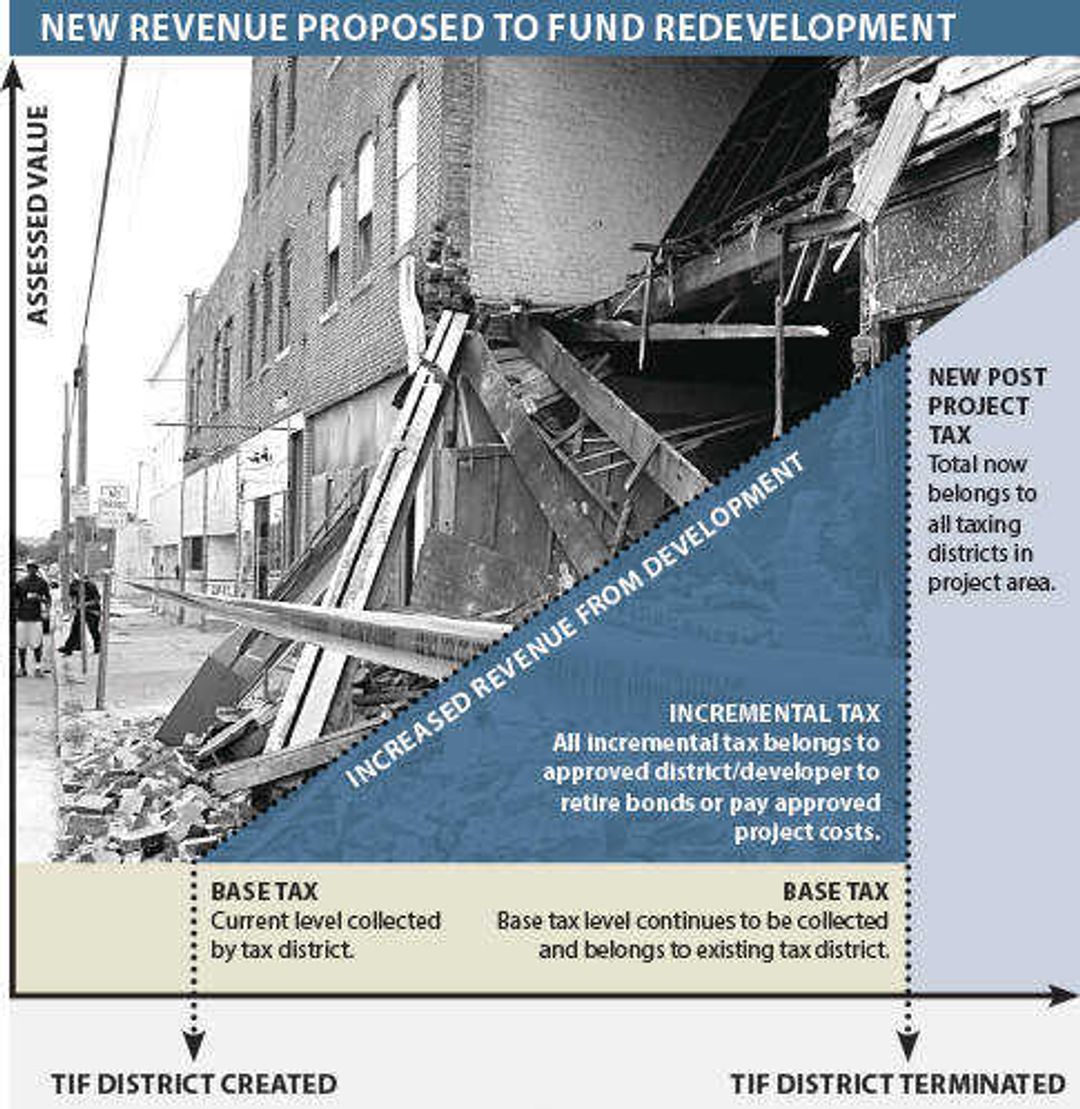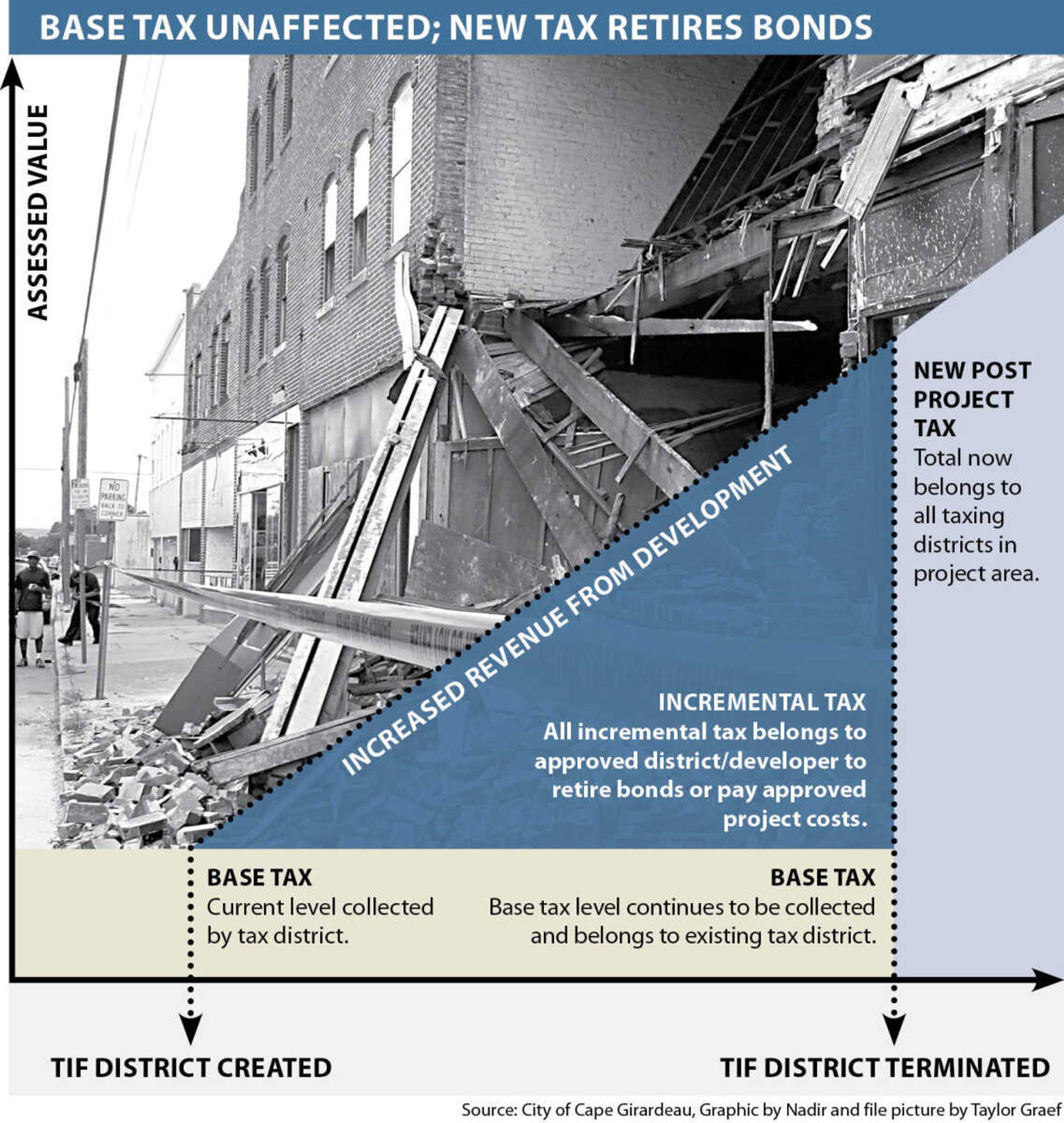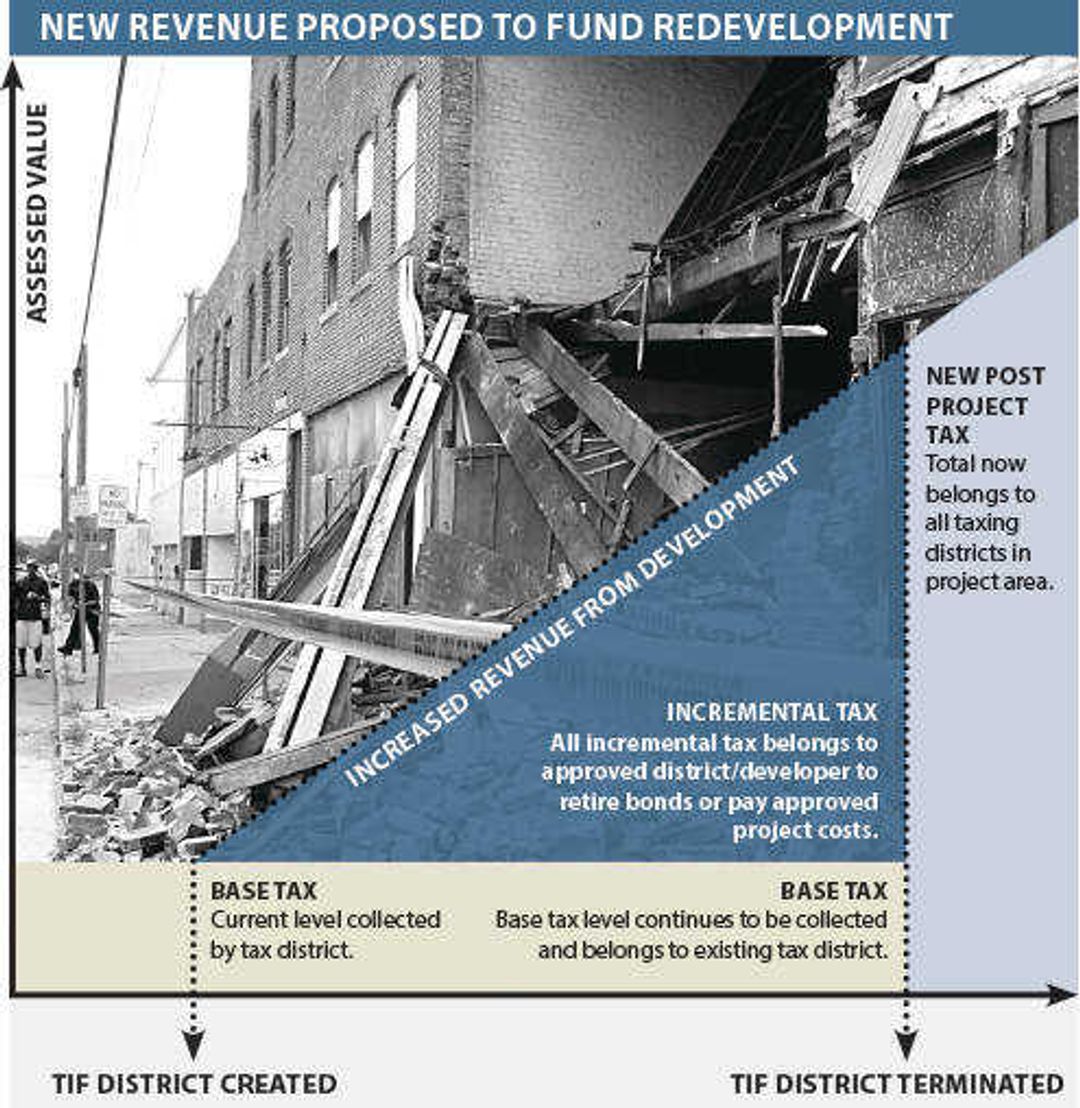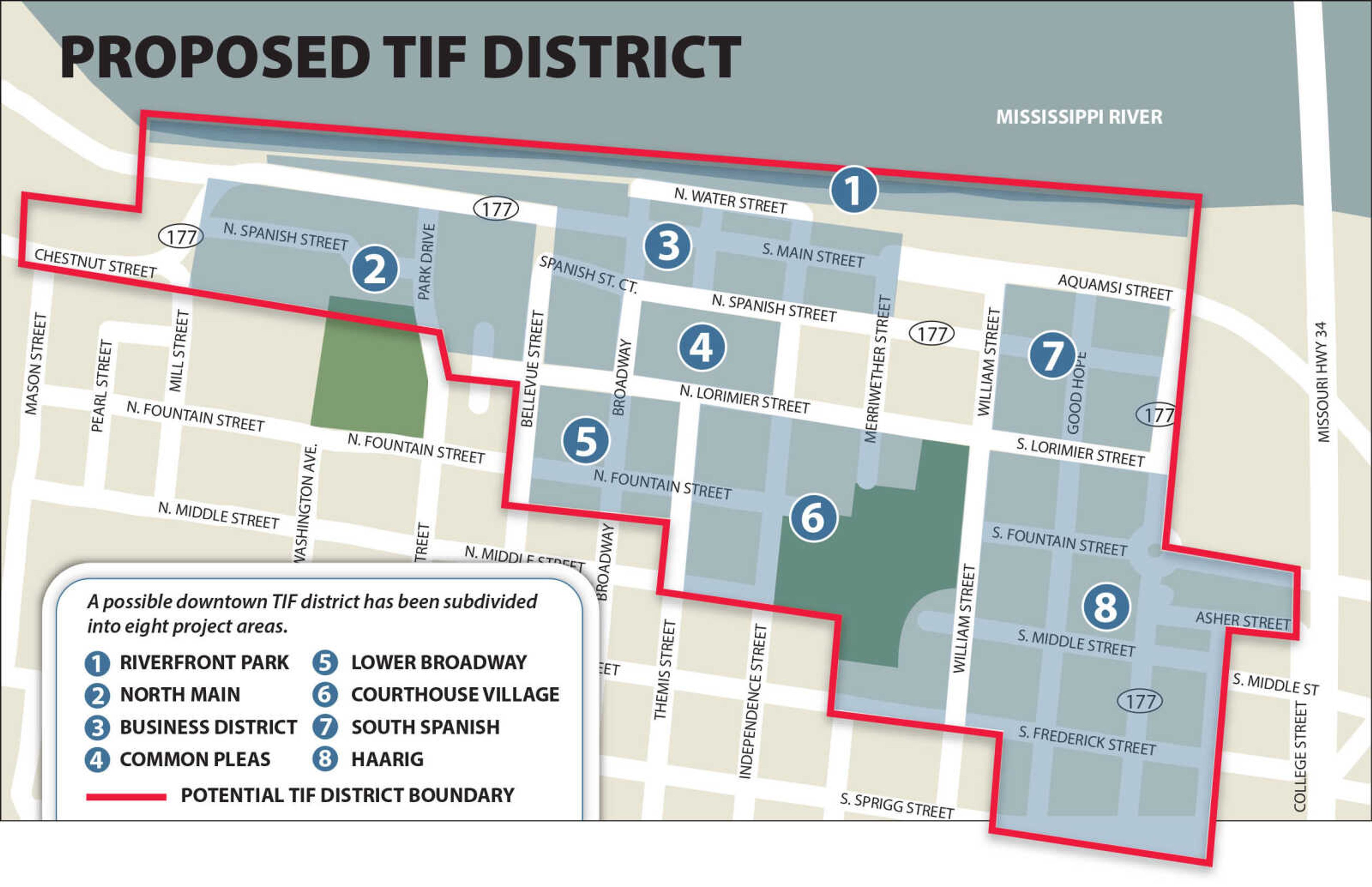Downtown Cape may create tax increment financing district
Downtown redevelopment has been a hot topic in Cape Girardeau for the past few years, and the city is preparing to take another step in an effort to encourage more development. At its Monday night meeting, the Cape Girardeau City Council will take some initial steps to creating a tax increment financing district...
Downtown redevelopment has been a hot topic in Cape Girardeau for the past few years, and the city is preparing to take another step in an effort to encourage more development.
At its Monday night meeting, the Cape Girardeau City Council will take some initial steps to creating a tax increment financing district.
The Cape Girardeau Area Chamber of Commerce and Old Town Cape prepared a possible district map for the city to consider. Council and staff have had opportunities to review, ask questions and offer suggestions, and Mayor Harry Rediger said everyone "is in concert with this."
Tax increment financing -- TIF -- is a method to encourage redevelopment in a "blighted area" or a "conservation area" as defined by Missouri law. The proposal under consideration approaches downtown as a conservation area. It's defined as a specific area within a city where 50 percent or more of the structures are 35 years old or older. The area is not blighted, but could become blighted because of dilapidation, deterioration, abandonment, excessive vacancies or other factors.
Establishing a TIF district would allow the city to help developers with rehabilitation costs and get some vacant and deteriorating buildings back into use, said Cape Girardeau Area Chamber of Commerce president and CEO John Mehner.
"TIF is designed by the Missouri Legislature to be used as a redevelopment tool," he said. "It's helpful with properties where there's not a good possibility for someone to develop on their own."
Some of the biggest redevelopment challenges are a structure's age and its rehab costs, Mehner said. Developers may be disinclined to rehabilitate a property because it would be more costly than building a new structure.
The theory of tax increment financing is by encouraging redevelopment projects, the value of real property in a redevelopment area will increase.
TIF allows the city -- which would be the master developer of the district -- to collect the increment gained in property taxes between the current value and the improved value, as well as 50 percent of the economic-growth-in-activity taxes that includes sales taxes and taxes on utilities. The city takes the revenue and invests it in approved developments -- funding needs such as parking, lighting, infrastructure and rehabilitation.

Projects must meet the "but for" test to be approved, Mehner said. "But for the assistance of TIF, the project could not be completed because it has too many needs or negatives to be feasible," he said.
But the city is a long way from adopting specific plans and project areas. The ordinance to be voted Monday night simply authorizes the distribution of a request for proposals to redevelop portions of downtown. By soliciting the proposals, the city may identify projects and possible use of TIF as a redevelopment tool. It also will help the city determine whether it's interested in forming a TIF district.
The current Downtown Strategic Plan, adopted in 2009, calls for establishing a TIF district.

An early district map -- the boundaries of which could be adjusted depending on the redevelopment proposals the city receives -- extends to the north to the Isle Casino Cape Girardeau parking lot and south to Shawnee Parkway, excluding the Southeast Missouri State University River Campus. To the east and west, it begins at the Mississippi River and expands in a stairstep-like fashion as far as Sprigg Street.
Some of the historic properties included in the possible district include the Marquette buildings along Broadway; the Hammelberger and Harrison Building, also on Broadway; Common Pleas Courthouse on Lorimier Street; and the Haarig Commercial District on Good Hope Street. City Hall is included.
Neither the Broadway nor the Esquire Theater is included in the suggested boundaries, which Mehner said were intentionally kept limited to be more manageable and focused. The boundary map also is highlighted with suggested redevelopment project areas that target specific areas such as the Haarig district, the riverfront and the South Spanish Street area.

The chamber of commerce, Old Town Cape and city of Cape Girardeau agree downtown is in the right place to begin considering a TIF district. The mayor said as far as development is concerned, "it's the best time to move ahead."
"We have seen a lot of development and a lot of momentum in the downtown area, and, of course, Old Town Cape just won a national award," Rediger said, speaking of the Great American Main Street Award received earlier this year. "We've got some people kind of nosing around, so we see future development, too, and we just felt all in all, it was the right time to do that, and then we just started looking at the areas and developed it from there."
Councilwoman Loretta Schneider said a strong downtown is crucial to a city, especially one the size of Cape Girardeau. The area has been on an upswing lately, and she said promoting redevelopment there would benefit the city as a whole.
"I think it is good timing," she said. "I can't see that there will be much opposition to it. It's not like we're passing a tax for anyone to develop that part of town."
Schneider has a long history on the council, so she knows tax increment financing isn't a new proposal for downtown. But more recent members, such as Councilman Victor Gunn, will not approach the latest plan with the benefit of past experience.
He said he's generally supportive of any plan that would benefit downtown and the city. Lots of people visit the river, and no one wants to see such a popular area surrounded by blight and other problems, he said.
Still, he would like to have more council discussion and hear from constituents before making a decision.
"I've been observing up to this point and am generally supportive," Gunn said. "I will wait until we hear from the public at meetings and such to see before I make a decision."
Public input will play a role in establishing a TIF district. Once the city issues the request for proposals, the council will begin appointing members to a TIF commission. It will consist of six city appointments, two county appointments, two appointments from the Cape Girardeau Public School District and an appointment representing the other taxing entities in the area.
The commission is required to hold a public hearing and make a recommendation to the city regarding a redevelopment plan, redevelopment projects and the designation of the redevelopment area. The city adopts the recommendations through the approval of ordinances.
Forming the commission and redevelopment plan is expected to take several months.
srinehart@semissourian.com
388-3641
Pertinent address:
Cape Girardeau, Mo.
Connect with the Southeast Missourian Newsroom:
For corrections to this story or other insights for the editor, click here. To submit a letter to the editor, click here. To learn about the Southeast Missourian’s AI Policy, click here.









